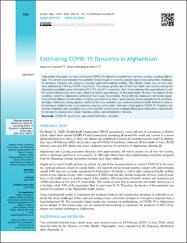| dc.contributor.author | Husseini, Abbas Ali | |
| dc.contributor.author | Kamil, Anton Abdulbasah | |
| dc.date.accessioned | 2023-09-26T07:26:25Z | |
| dc.date.available | 2023-09-26T07:26:25Z | |
| dc.date.issued | 2020 | en_US |
| dc.identifier.issn | 2149-2247 | |
| dc.identifier.issn | 2149-2549 | |
| dc.identifier.uri | https://hdl.handle.net/11363/5661 | |
| dc.description.abstract | Little reliable information on novel coronavirus (COVID-19) outbreak is available from war-torn countries, including Afghanistan. The current study estimates the pandemic features based on currently available data to forecasting future challenges
of preventive strategies and emergency response using mathematical modeling. The infection fatality and recovery rates
were estimated by 1.8% and 20.8%, respectively. The average growth rates of infection, death, and recovery among the
Afghanistan population were estimated as 0.2, 0.2, and 0.5, respectively. Also, it was estimated that approximately 6 million people infected in the urban area, which may lead to approximately 11 thousand deaths. However, the features of the
pandemic, marks that Afghanistan needs more time to pass the pandemic. Along with this, inadequate community engagement and low abiding to health advice, including social distancing, lack of personnel and testing capacities in the provinces,
shortage of laboratory testing supplies, insufficient infection prevention, and control measures in health facilities in some of
the provinces, limited access to and response capacities are the main challenges to fight against COVID-19. Therefore, the
majority of infected cases and deaths may not be reported, and preventive strategies effectively in Afghanistan could severely
be disrupted by several socio-cultural, financial, political, and administrative obstacles. | en_US |
| dc.language.iso | eng | en_US |
| dc.publisher | ERCİYES ÜNİVERSİTESİ TIP FAKÜLTESİ | en_US |
| dc.relation.isversionof | 10.14744/etd.2020.80270 | en_US |
| dc.rights | info:eu-repo/semantics/openAccess | en_US |
| dc.rights | Attribution-NonCommercial-NoDerivs 3.0 United States | * |
| dc.rights.uri | http://creativecommons.org/licenses/by-nc-nd/3.0/us/ | * |
| dc.subject | COVID-19 | en_US |
| dc.subject | growth rate | en_US |
| dc.subject | exponential distribution | en_US |
| dc.subject | estimation | en_US |
| dc.title | Estimating COVID-19 Dynamics in Afghanistan | en_US |
| dc.type | article | en_US |
| dc.relation.ispartof | Erciyes Medical Journal | en_US |
| dc.department | Sağlık Hizmetleri Meslek Yüksekokulu | en_US |
| dc.authorid | https://orcid.org/0000-0002-8861-7106 | en_US |
| dc.authorid | https://orcid.org/0000-0001-5410-812X | en_US |
| dc.identifier.volume | 42 | en_US |
| dc.identifier.issue | 4 | en_US |
| dc.identifier.startpage | 468 | en_US |
| dc.identifier.endpage | 473 | en_US |
| dc.relation.publicationcategory | Makale - Ulusal Hakemli Dergi - Kurum Öğretim Elemanı | en_US |
| dc.contributor.institutionauthor | Husseini, Abbas Ali | |
| dc.contributor.institutionauthor | Kamil, Anton Abdulbasah | |



















